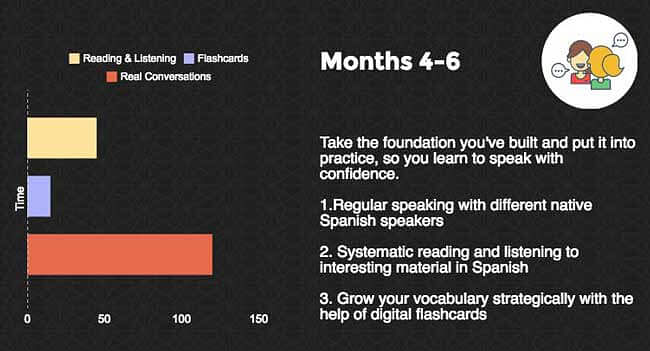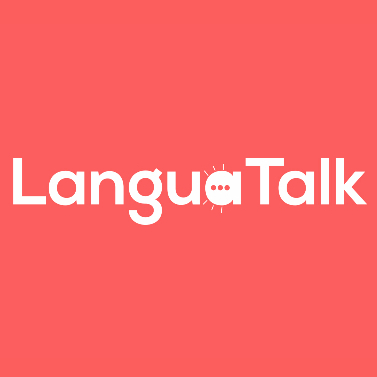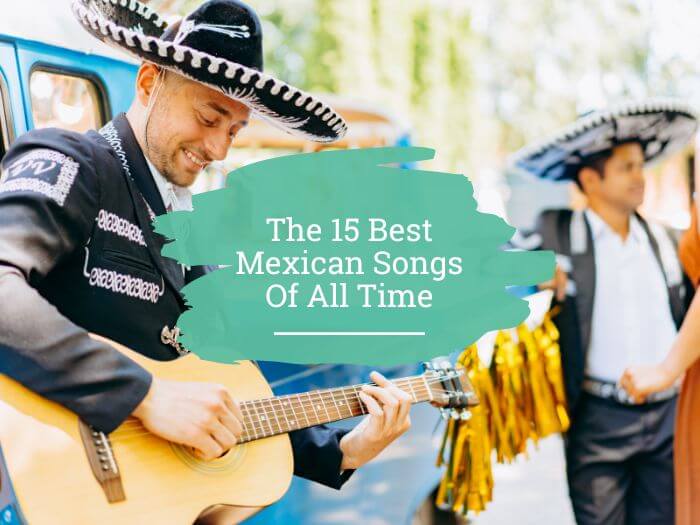So you're looking for the best way to learn Spanish on your own?
In this post, you'll learn – in detail – the exact steps you need to become fluent, including…
- Best Spanish resources
- Most effective study techniques
- How much time to spend
If you're looking for the fastest and most enjoyable way to learn Spanish, then I recommend the Spanish Uncovered programme.
With Spanish Uncovered you'll use my unique StoryLearning® method to learn Spanish through story… not rules.
It's as fun as it is effective.
If you're ready to get started, click here for a 7-day FREE trial.
But otherwise, here's what you're learn in this article…
I'll break the process down into four stages:
Table of Contents
(These are the same stages I used to become fluent in Spanish myself)
Sound good?
You'll learn the process that experienced language learners use to study languages on their own – without following an expensive programme of study in a language school.
You also discover the best way to learn Spanish on your own without moving to Spain, talking to strangers on the street, or spending your life buried in books.
- Don't have time to read the whole post now? Download a free PDF so you can read in your own time. Click Here
Ready? Great!
Let's look at an overview of the entire process. Then, I'll explain each part in detail.

By the way, if you're learning Spanish, then you're probably interested in the origins and history of this beautiful language. In which case, I've got a real treat for you, my video all about the true story of the world's second biggest language. Just hit play below to check it out.
The Best Way To Learn Spanish On Your Own
Let's have a quick reality check!
If you want to learn Spanish independently, you're going to need a few things…
- Motivation (to keep going)
- Focus (to be effective)
- Time (for everything to sink in)
Without these three things, it's impossible to learn a language.
From all my work with language learners, there seems to be one killer way to set yourself up for success: Keep it simple!
With tonnes of Spanish websites, apps and courses out there, it can be tempting to jump from one to the next.
But there's one golden rule to remember…
It's usually more effective to calmly work your way through one book, or stick with one study method, than to try different things out of curiosity.
The focus you'll get from this keeps self-doubt away, and helps you learn more deeply.
Getting Started: The First Few Weeks

What: Spend the first few weeks with an introductory Spanish audio course.
When: Ideal for your commute. 30-40 minutes a day. Two separate 15-20 minute sessions are ideal, as this helps memorisation.
Recommended Resources:
How: This bit's easy – just follow the course as recommended
Why: Spanish Uncovered teaches you Spanish using the power of story. Instead of getting bogged down in grammar, you listen and read an immersive story.
You pick up the grammar later, after reading. You main job is to listen, read and enjoy the material.
Months 1-3: Build Your Foundation
What:
- Work systematically through a good online Spanish course (such as Spanish Uncovered)
- Practise talking about the contents of the course with a speaking partner/tutor – on LanguaTalk, you can find talented, native Spanish tutors who offer personalised lessons
When:
Every day:
- 30-45 minutes: Course study
- 15 minutes: Revision
2-3 times per week:
- 30 minutes: Speaking practice
Recommended Resource:
Why: After easing yourself in to your Spanish journey, you now have a challenge… “What's the fastest, most effective way of building a strong foundation in Spanish?”
The answer is deliberate, consistent practice with a comprehensive Spanish course.
I spent thousands of hours creating my Spanish Uncovered course and carefully chose exactly what to teach, how and when. So the best way to learn Spanish on your own (at the beginning) is actually far simpler than you might think: Simply enrol in the course and work through it chapter by chapter.
To go a step further, you'll need to practise what you learn. If everything you learn just lives in your head, it remains passive knowledge. If you want to speak Spanish, you need to activate that knowledge.
For this reason, you'll start to practise what you learn with a speaking partner from the start. In Spanish Uncovered, I've included a set of speaking activity packs so you can do just that. Just share them with a Spanish speaking friend or tutor and you're ready to start practising your speaking!
Learning With Stories
The most effective way to learn Spanish is through stories not rules.
Most courses and textbooks will include hundreds of grammar exercises to follow, and Spanish Uncovered is no different. These exercises are useful to help you practice what you're learning but it's not these activities that help you build a strong foundation in Spanish.
The magic really happens when your spend time reading and listening to Spanish. A strong foundation comes from spending your time with the language in context, and learning what you need to make sense of it.
Specifically, this means: Learning through story. In Spanish Uncovered, you'll…
- Read and listen to each dialogue many times
- Gradually go from not understanding to 100% comprehension
- Use the grammar lessons in the course to help you understand what's going on, but don't worry about memorising all the rules
You can use this approach to systematically work your way through any Spanish course. Just make sure you're spending most of your study time with the language and less time on rules and exercises.
You can always go back and study the grammar later, but it's by spending time reading and listening to Spanish that you'll get the most complete picture of how Spanish works. (This is known as a top-down approach.)
To find out more about how my StoryLearning method works, read this article.
Revision
For a long time, I believed that the way to learn a language fast was to learn more.
Eventually, I learnt that the way to learn a language fast is to revise more.
Beyond your daily habit of studying your textbook, the single biggest thing you can do to improve your learning is to add a revision session at the end of the day.
In this session, you simply look back over what you did earlier, and do more of the same…
- Read the story again
- Can you remember the new vocabulary?
- Can you understand the audio without reading?
Without the revision, there is a 24 hour gap between study sessions. With the revision, you have an opportunity for your brain to absorb what you're learning.
Speaking
Now, I know you're looking for the best way to learn Spanish on your own. However, you do want to learn to actually speak Spanish, right?
This means you'll need help, and you can't do it all by yourself. You'll need a speaking partner or a tutor. You can find a Spanish tutor on LanguaTalk. It's our #1 recommendation as it has dozens of talented native teachers and a really intuitive interface.
However, you may wonder how you can start speaking Spanish when you're a beginner. This approach gives you a convenient way to get started:
- Study a chapter of your course until you feel you've absorbed it
- Practise the material from the course with a speaking partner
You can:
- Role play the dialogue
- Practise using and manipulating new grammar (Yo voy a la playa, nosotros vamos a la playa, etc)
- Make up sentences using new vocabulary (Vamos a la playa, vamos al restaurante, vamos al río)
30 minutes is usually enough for speaking sessions, and you might want to spend a number of sessions practising one textbook chapter, and that's fine.
Just remember to keep moving through the book, and not to aim for perfection.
When learning Spanish as a beginner, it's far better to gain a limited understanding of many areas than a deep understanding of a few. This is because lots can be learnt intuitively, without the need for dedicated study, so it's better to cover a lot to increase the chances of that happening.
Danger: These days, comprehensive approaches can be overlooked, in favour of smartphone apps. (You can blame the “App Villain” for that!) Although you can find some great resources on your smartphone, apps are disastrous in one important aspect: focus.
The major advantage of a more comprehensive course, in my opinion, is that it makes the job of focusing so much easier.
Turn off your phone, forget the “shiny objects” and just concentrate on the next lesson in your course. Everything you need is there.
Months 4-6: Speak And Read

What:
- Regular speaking with different native speakers
- Systematic reading and listening to interesting material in Spanish
- Grow your vocabulary strategically with the help of digital flashcards
When:
Every day:
- 45 minutes: Reading with text and audio
- 15 minutes: Study new vocabulary with flashcards
2-3 times per week:
- 1-2 hours: Attend Spanish Meetup/language exchange, or speak with friends/tutors
Recommended Resources:
You will need a variety of material depending on interest. Try to find reading material that comes with audio:
- Fluent Spanish Academy – a library of engaging study material especially for intermediate learners
- Short Stories in Spanish for Beginners (with audio)
- Short Stories in Spanish for Beginners Volume 2
- Short Stories in Spanish for Intermediate Learners
- 101 Conversations In Simple Spanish
Why:
After 3 months of study, you should have a good foundation in Spanish to a pre-intermediate level (A2). In months 4-6 you aim to take that foundation and put it into practice, so you learn to speak with some confidence.
At this stage, you may find yourself hitting a plateau, where you seem to stop improving.
This happens because you've already learnt all the low hanging fruit in Spanish, such as cognates, common Spanish words/phrases etc.
In reality, progress seems slower because you begin to realise just how much you don't know, and you have a desire to speak with more accuracy.
The route to developing confidence in Spanish is this: Spend as much time using Spanish to do things that interest you, and do this using all four skills – speaking, listening, reading, writing.
People who fail to break through this plateau usually do so because they spend too much time studying the language, and not using it for real purposes (e.g. reading, speaking).
The activities in this phase are designed to make sure you spend as much time as possible engaging with the language.
You may feel you lack structure without a textbook or course, but have faith in the process of surrounding yourself with real Spanish – it will ultimately pay off, as things slowly start to make sense and you learn to control the language.
Speaking
In the previous phase, you worked with native speaker tutors to help you practise language from your textbook. Now, it's time to get more authentic speaking practice.
The trouble is, speaking with native speakers can be scary. So, you're not going to throw yourself in at the deep end.
Rather, you're going to continue working with tutors or conversation partners who you're familiar with, and attending Meetups where everyone is there to practise Spanish (i.e. they're in the same boat as you!)
For me, speaking Spanish “fluently” isn't about being native-like. It's about being able to enjoy interesting conversations with native speakers. (There's a big difference!)
In your daily life, you tend to discuss similar topics every day with your colleagues and friends. Spanish should be no different:
- Decide on a topic that interests you (for me, that might include: language learning, London, politics, travel, self-development)
- Tell your tutor the topic you've chosen
- Use your speaking time to discuss that topic, asking for help when you struggle to express yourself
- When the discussions have run their course, move onto the next topic
In these conversations, your aim should not be to get everything correct. You are practising expressing yourself.
I find it helpful to think about the point I'd like to make in English, and then try to say that in Spanish. This helps to ensure I'm being a good conversation partner, and not just trotting out formulaic Spanish I've learnt.

By the way, one of my favourite ways to practise speaking Spanish is with a language teacher.
You can find talented, native Spanish teachers on LanguaTalk, my #1 recommendation for personalised 1-on-1 language lessons.
You can book a free trial session (no card required) here.
Reading And Listening
Spend your study time reading interesting material in Spanish.
The ideal material is:
- Interesting to you personally
- Graded to your level
Simplified material isn't always easy to find, but the Fluent Spanish Academy gathers everything together in one place, as a one-stop shop for intermediate Spanish learners.
The most important thing it to read on topics that interest you. This way, you learn relevant Spanish rather than trying to learn every noun, verb and adjective under the sun.
By reading and listening at the same time (to identical material), you can form links in your mind between the words and the sounds. You can also use the text to understand the audio which might otherwise be too fast.
Reading teaches you so much. (That's why I wrote my books of Spanish short stories for beginners.)
Many perceived difficulties with Spanish grammar can be solved simply by reading a lot. When you see the grammar being used in a real context, it intuitively starts to make sense. I believe this is much better way to learn grammar than trying to study it in an isolated way in a textbook.
Treat reading as your main Spanish study each day. You can do it in one long session (45 mins), or do it on your commute (2×20 mins).
For an effective reading strategy, click here.
Strategic Vocabulary Study
As your Spanish improves, you realise that there are tonnes of words you don't know.
To make matters worse, that vocabulary becomes harder to memorise because you see it less often.
If you're reading Spanish and having regular conversations, you'll be learning a lot of new vocabulary naturally. But rather than leave it to chance, you can use digital flashcards to help commit the most useful vocabulary to memory.
The trick here is to be selective about which vocabulary you try to learn. You can't learn everything, so try to notice the words and phrases you come across in your other activities that seem to be highly useful.
Use your flashcard app as a place to store this vocabulary, and use the “Spaced Repetition System” to help you commit it to memory.
Some people find it hard to get excited about using flashcards for language learning, but it's very powerful and you can commit a lot of vocabulary to memory within a short time.
The most effective way to learn Spanish vocabulary with flashcards is to do multiple, short sessions a day. The recommended 15-20 minutes per day is best broken down into 3 or 4 short 5-minute sessions study. You can easily fit these into coffee breaks or waiting for the train.
Danger: The hardest part of learning Spanish on your own, especially at the 4-6 month stage, is the lack of structure. This is the Inconsistency Villain at work!
You might be unsure you're studying in the right way, without the structure provided by a regular class.
3 months of regular reading, listening and speaking will teach you a lot of Spanish naturally. But it needs to be focused. It's vital to choose reading material that's at a suitable level for you, or else you'll struggle.
(By the way, not sure of your current level in Spanish? Take my FREE online Spanish level test and find out!)
The biggest “hack” in this process is the strategic learning of vocabulary with flashcards. Most people shoot themselves in the foot here by trying to learn too much.
Flashcards can quickly become overwhelming if you cram them with vocabulary you don't really need. Be always thinking: “What's the most useful stuff here? What will really help me speak better?”
This means the 15 minutes you spend on this each day are highly targeted, and make a direct contribution to your fluency.
You will still find speaking hard at this stage, and that's OK. Your attitude is important here. If you focus on everything you can't say, you'll become negative and want to retreat to your books. Instead, focus on the process of simply speaking week after week, and the benefits that come from that.
Months 7-12: Lifestyle Changes

What:
- Switch your daily activities from English to Spanish, and create a social life based on Spanish
- Read real Spanish
- Study grammar in more detail
When:
Every day:
- 45 minutes: Read real Spanish on topics of interest
- 15 minutes: Work through a Spanish grammar book
- All day: Replace your daily activities with Spanish – news, movies, weather, recipes
2-3 times per week:
- Attend Spanish cultural events, Meetups, etc. and surround yourself with the language
Recommended Resources
Replacing your daily activities with Spanish will take a bit of preparation, but it's easy to find everything you need online:
- News: http://www.elmundo.es/
- Weather: http://www.eltiempo.es/londres.html
- TV: http://wwitv.com/television/191.htm
- Movies: http://screenrant.com/best-spanish-language-movies-tv-series-stream-netflix/ (Have you seen the Spanish versions of Breaking Bad or Downton Abbey?
- Cooking: http://www.quericavida.com/recetas
In addition:
- Do your Google searches in Spanish: http://google.es
- Set your phone to Spanish: https://support.apple.com/en-us/HT204031
- Set your PC to Spanish: http://www.idganswers.com/question/11894/how-to-change-language-to-spanish-in-windows-7
Grammar:
- Fluent Spanish Academy – The Academy contains a collection of Short Stories that are written using specific grammar points, and is the best resource for improving your grammar in a natural way.
- Spanish Grammar Hero
Why:
After 6 months of studying and – critically – using Spanish, you will be in a good place.
Now it's time to do two things:
- Make Spanish part of your lifestyle by replacing your daily activities in English
- Improve the accuracy of your Spanish by studying grammar in more depth
In the previous 3 months you were looking for reading material that is simplified for beginners, and speaking opportunities that are designed for learners.
However, now you need to dive into real Spanish. Real Spanish is where you'll learn how the language is really used, and have the chance to speak with real people – not sugar-coated to make it easy for you.
The way to make this meaningful, and not get overwhelmed, is to continue basing your studying around your own interests:
- Read the news you want to read
- Watch the Spanish movies you want to watch
- Attend the events you want to attend
By keeping everything centred around your interests, you achieve two things:
- It's easier to stay motivated
- You don't have to learn every Spanish word under the sun. You focus instead on vocabulary that you're more likely to want to use in your daily life.
Naturally, this is not easy – especially at first. But by rising to the challenge, and keeping it up for 6 months, you'll reach the end of the 12 months with a significant amount of ability in Spanish.
(The star of the Netflix blockbuster Narcos used these principles to learn Spanish in only a few months. Read how in this post!)
Study Grammar In More Depth
Spanish is what you might call a “front-loaded” language. In other words, much of the difficulty comes at the beginning. Once you can speak Spanish to a decent level, you won't find any big surprises (unlike many Asian languages, for example).
Until this point, I've suggested you don't study grammar in much depth.
The reason is that most people believe the best way to learn Spanish on your own is to master grammar from the beginning.
This is a mistake, because it's easy to get bogged down with tricky grammar points that you don't actually need in order to speak.
However, now that you can speak, it's time to look at refining your grammar.
Luckily, you'll find that you've already learnt a lot of that so-called “tricky” grammar simply by being exposed to it over the last 6 months – so it will prove to be much easier to master.
For the same reason, it makes sense to study grammar systematically at this stage, and you can do this by working through a good grammar exercise book. Simply focus on the areas of grammar you find tricky.
Switch Your Daily Activities To Spanish
At the same time as you work on your grammar, you need to start making Spanish the default language for your daily activities.
There's no need to look for “soft” options any more!
You should literally try to do everything you need to do in Spanish, whether that's reading the newspaper or going out for the evening.
This isn't particularly complex to do, but it does take commitment.
The best way to approach this is to start small. Introduce one new Spanish activity every week.
Start with your daily news fix.
Then, the following week, switch Google to Spanish. And so on.
Ideally, your speaking practice will come from a Spanish-based social life. However, if this isn't practical (perhaps due to where you live), you should arrange regular speaking sessions on Skype.
Just remember, these should not be “lessons” where you are taught, simply sessions where you have an opportunity to speak about topics of interest.
Here's how to structure and prepare for these sessions:
Read Real Spanish
It's still important to maintain your daily study time, as this gives you structure.
Continuing the theme from months 4-6, you're now going to read as widely as possible.
Set a regular time every day to read, and stick to it.
In terms of reading material, ideally it should be something you'd read for fun in your mother tongue. Given the choice, non-fiction tends to be simpler to read than fiction. Similarly, magazines and Spanish blogs can make for good reading material.
Personally, I like to read physical Spanish books or magazines, because reading “offline” helps me to focus.
Danger: By now, you're using Spanish for real purposes, almost like performing a “language transplant” on your life! And that's what will ultimately bring you the confidence and fluency you want.
However, to make it a success, you do need to create your own structure, and this means…
- Schedule your study and speaking times
- Choose material and topics that are genuinely interesting for you
These things seem almost too simplistic, but failing to study regularly, or reading boring things, will quickly kill your progress.
Conclusion – The Best Way To Learn Spanish On Your Own
I hope you've been able to take some inspiration from this study plan!
I've really tried to boil the process down to the elements that will really result in your learning Spanish – not just studying it.
As I said at the beginning, the best way to learn Spanish on your own will always be the simplest.
Because ultimately, you're the only one holding yourself accountable.
Take this plan as a blueprint, commit to sticking at it, and get stuck in! And if you'd like a helping hand, check out Spanish Uncovered. You can start today with a 7-day FREE trial.
¡Buena suerte!
Do you know someone who wants to learn Spanish? Please share this post with them, or click here to send a Tweet!














































